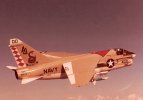I'm not convinced that you CAN'T build one airframe to work for all three services, but there will of course be compromises made...
It's a pretty short list of really great historic examples out there, but plenty of OK (or worse). Everybody knows that the F-4 started out as a fleet interceptor, was soon adapted to other roles, and worked out great across three services. Aaaaaand...
... the short list of "great" pretty much ends there.
F-18 is actually another good example (it does good work in a lot of air forces around the world... disclaimer- just not our own air force, of course because of the history and politics of how the entire program came to be)
Harrier... this is another good example (never used by our AF though) *
F-14... maybe an OK example (again, just never used by our own AF and, as I recall, high cost made for very very few customers in the end)
A-7... did OK as multi-service, but then it was never a multirole platform
Lots of great helicopter examples (H-1, H-3, H-53, H-46, H-60), but these are utility platforms by nature. Apples and different animals and all that.
The only thing I can think of that these all have in common is that they weren't originally intended to be multi-service

??
edit:
Let me clarify for Fog. There has never been a successful transition of a fixed wing aircraft to sea service from a shore based service.
* Harrier if we include international examples. I know, not fair
 , but I think it's worthwhile to include it in the analysis. (And I forgot the A-1 that you mentioned.)
, but I think it's worthwhile to include it in the analysis. (And I forgot the A-1 that you mentioned.)

